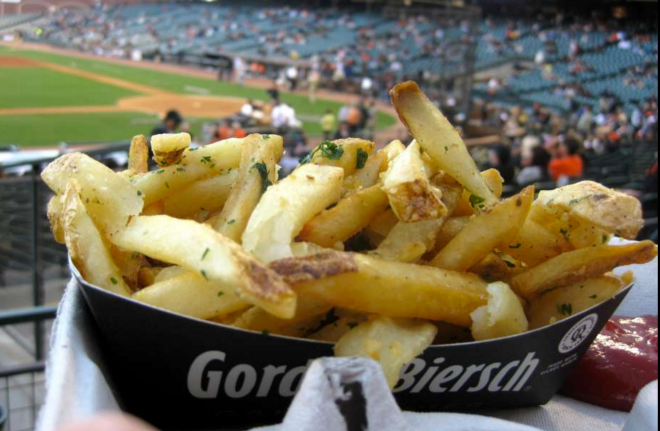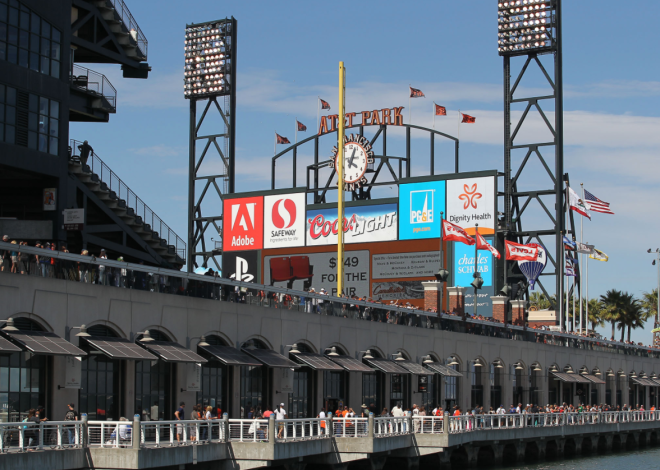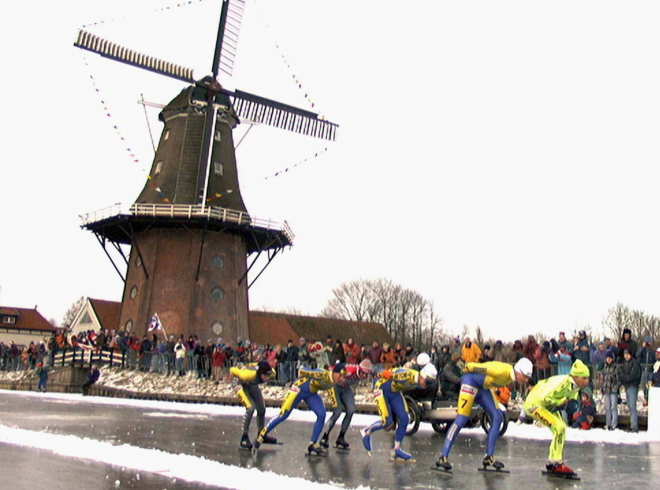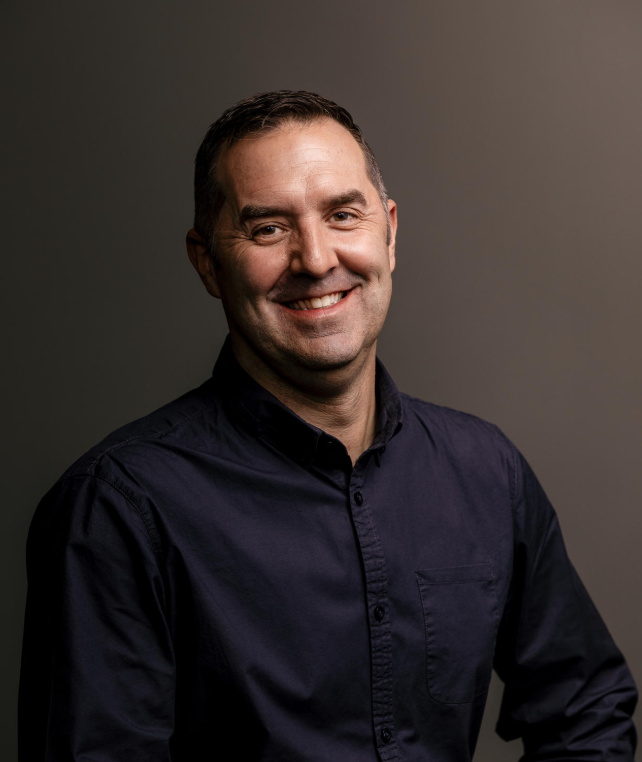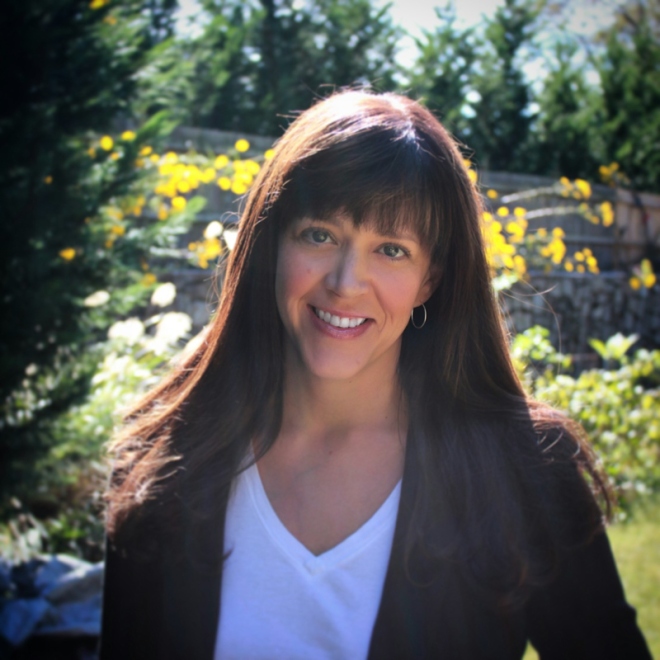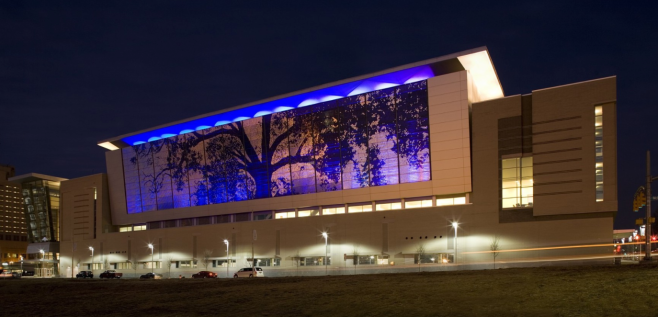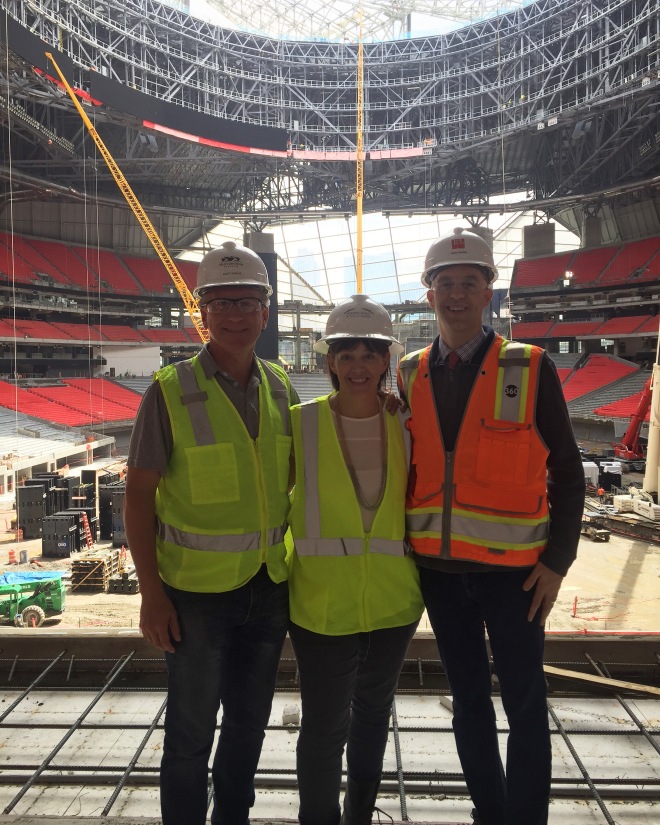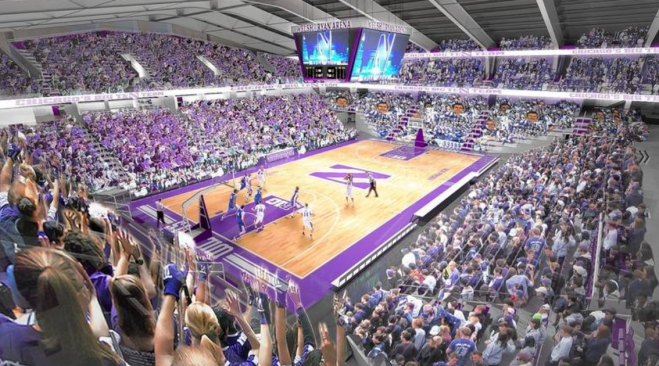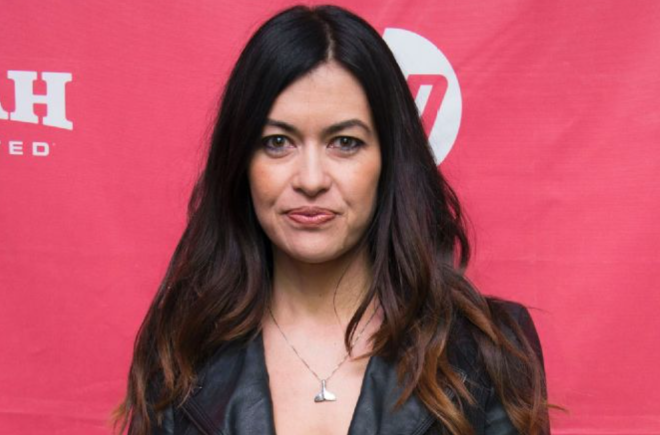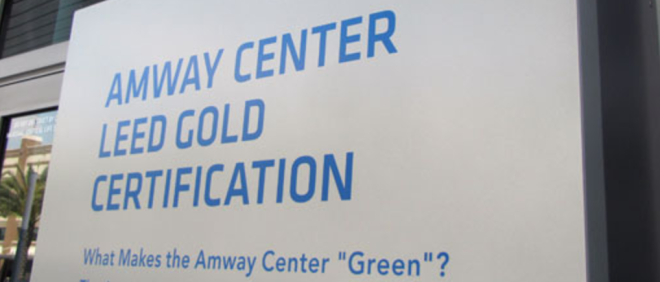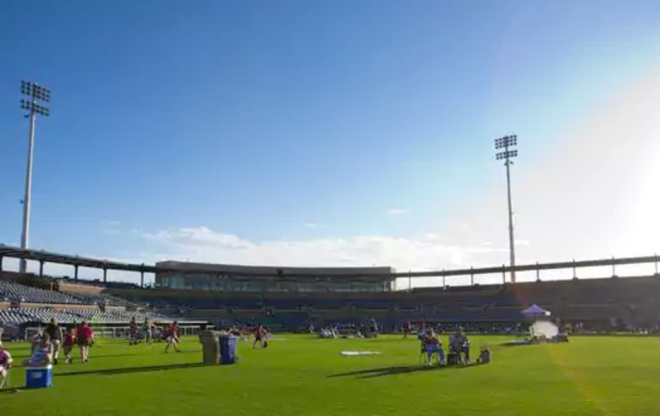Summer Minchew, Managing Partner of Ecoimpact Consulting, has worked on several stadium and arena projects, helping them through the LEED certification process and much more.
GreenSportsBlog spoke with Minchew about Ecoimpact Consulting’s innovative approach to sustainability that combines environment and efficiency with human health and wellness.
GreenSportsBlog: How did you get in to the sports venue sustainability space?
Summer Minchew: Well, Lew, I’m a bit of a rarity in this business in that I have stadium design in my blood. I grew up in Kansas City and my dad happened to be a lead project sports architect…
GSB: No WAY!
Summer: Yes WAY!! My dad worked on the Moda Center, home of the Portland Trail Blazers; the AT&T Center, home of the San Antonio Spurs; and Bankers Life Arena, where the Indiana Pacers call home, along with many more. I grew up around sports architecture. Funny thing, though: I’m not a sports fan. But even as kid I loved drawing designs for buildings…
GSB: …Funny thing is, when I was a kid I used to draw stadiums. Only thing was, I had no drawing talent. You clearly had it. So what did you do?
Summer: I went to Kansas State in Manhattan…
GSB: Manhattan, Kansas, the “Little Apple.” I’ve never been.

Summer Minchew (Photo credit: Melissa Key)
Summer: It’s a great place. I went to the College of Architecture Planning and Design. During my college internships, I worked for a few of the sport architecture firms in Kansas City …
GSB: …Kansas City is basically the hub for sports architecture, right?
Summer: That’s right. So when I graduated from college I moved to Charlotte and worked for a firm that was the associate architect on the Spectrum Center, home of the NBA’s Hornets. This experience became my foundation in sports architecture. From there, I moved to working mostly on interiors for corporate office space.
GSB: What do you mean by “interiors”?
Summer: Interior architecture and design. I love its focus on how humans interact with a space and how that space impacts humans. Consider that Americans spend approximately 90 percent of their time indoors. That connection is what drew me to sustainability: Green design is good design, it’s good for people, good for the planet.
GSB: That’s…good! What happened next?
Summer: I moved to Washington, D.C. in 2008 and worked for a firm called Envision Design, which has since merged with Perkins & Will. In 2006, the District passed the D.C. Green Building Act — all new non-residential public buildings were now required to pursue LEED certification. I was in the right city at the right time — and fortunately my mentors already had incredible sustainability ethos’, so it was a great place to be. One of my favorite projects while I was in D.C. was working on the design team for the US Green Building Council’s headquarters. Not surprisingly they wanted their space to be LEED Platinum. It was so great working on a project where the sustainability charge was client and mission driven, it really pushed the team to maximize the project’s performance. This was a phenomenal experience.
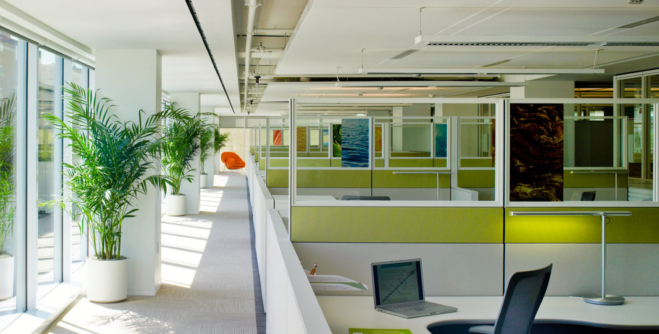
Interior shot of US Green Building Council’s Washington, D.C. LEED Platinum-certified headquarters (Photo credit: Eric Laignel)
GSB: Sounds amazing. What did you do with that experience?
Summer: Having discovered my love for, and gaining expertise in the green building certification process, I began working with Ecoimpact Consulting in 2010. Quickly I came to manage all of the firm’s green building certification projects.
I worked with Penny Bonda, one of the firm’s founders, and eventually became her partner. She is truly incredible, an active participant in the green building industry since its very early stages. Penny pioneered the development of the LEED for Commercial Interiors rating system and co-authored Sustainable Commercial Interiors. I was contributing author on the second edition of the same book, published by Wiley and Sons in 2014. Penny retired in 2017 — but still serves as a trusted advisor to the firm.
GSB: Sounds like you and Penny were — and still are — a great team. What does Ecoimpact Consulting do?
Summer: The bulk of our work is management for green building project certifications, often supplementing a project team that needs to bolster their expertise in LEED.
From a LEED perspective, a sports venue can be a challenging building type. The prescriptive requirements in the LEED rating system can be difficult to adapt to sports projects, especially open-air venues.
GSB: What are prescriptive requirements?
Summer: With venues you have fluctuating operating hours and occupant densities, untraditional floor plans and less defined indoor and outdoor spaces than other building types. You have to know the rating system well in order to interpret the requirements and make sure you are meeting your intended goals. But it can also present some great opportunities to push the envelope and I’ll tell you, the challenge is worth it.
I don’t need to tell your readers that sports architecture is a very high-profile building type. Venues are meant to draw attention, attract fans and create a sense of place. Stadiums and arenas are more than just buildings, they are the physical embodiment of the brand. Increasingly the brand is not only about the league and the franchise but also about sustainability, community outreach, social and economic responsibility; and these building types have an amazing platform to reflect those values.
You can see the immediate impact in outcomes like a LEED certification and then hopefully a ripple effect in the influence of sustainable design and operations choices. I love the work!
GSB: Sounds like it. When you look at sports venues from human and sustainability perspective, what are you looking for?
Summer: We look at sustainable strategies not only from an efficiency perspective but also from human health and wellness points of view. For example, a venue with access to public transit not only reduces transit related greenhouse gas emissions and hardscape related heat island and stormwater management issues, it provides fans with increased opportunities to be physically active and better air quality for the surrounding neighborhoods. Access to natural light not only reduces overhead lighting costs but studies also show that access to daylight and views in the built environment positively impacts the health and productivity of building occupants. You get the idea. In any building, and sports venues are no exception, one of the most critical measures of building performance is occupant satisfaction.
GSB: No doubt about it. While you are a LEED AP and have been talking about LEED, it sure sounds like your work is more focused on the WELL standard.
Summer: Not necessarily. If you look at the point allocation of LEED, credits related to climate change represent the largest percentage of available points but coming in at a close second are credits related to human health. LEED does not simply evaluate energy, water and waste reduction, an integral component is the indoor environment including occupant comfort. WELL takes the human health and wellbeing baton to the next level, focusing on nutrition, fitness, mood and even sleep patterns of building occupants…
GSB: So it sounds like your work takes into account LEED, along with using WELL-type principles. Can you give an example of a stadium or arena project that is an example of the Ecoimpact Consulting approach?
Summer: We served as sustainability consultant on Audi Field, the home of D.C. United of Major League Soccer that opened last summer. We worked with Michael Marshall Design, the associate architect for the project supporting Populous. It’s a great venue, from its location to its design, its energy efficiency, on-site renewables and operational waste reduction strategies. Audi Field sits on what was a brownfield site — it had been a scrapyard before. It’s in the Southwest Waterfront area of Washington, which is making a comeback, close to the D.C. Metro’s Green line.
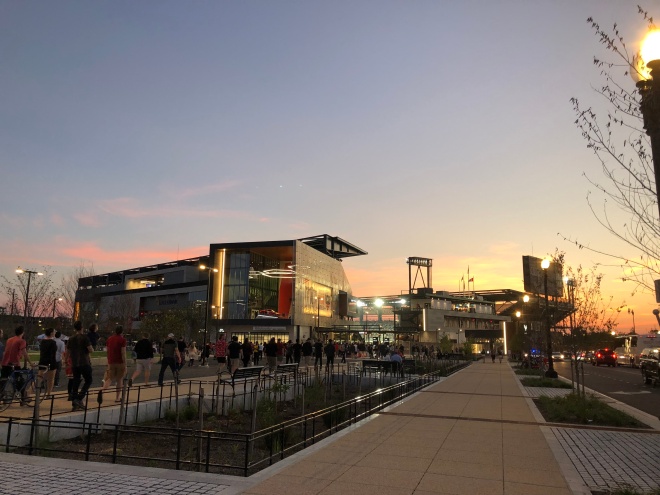
Exterior of Audi Field, home of D.C. United (Photo credit: Ecoimpact Consulting)
GSB: That’s right. Nationals Park, home of the Washington Nationals and the first LEED certified MLB stadium, is nearby and was an important anchor for the area’s revitalization. I haven’t been there yet but Audi Field is high up on my newly created Green-Sports Venue Bucket List. Talk more about Ecoimpact’s involvement with the project…
Summer: Well, we helped shepherd the project through LEED certification — Audi Field ultimately earned LEED Gold certification…
GSB: Congratulations!
Summer: Thank you. The project earned 64 points. One of the most visible sustainability features is their prominent bike valet which includes 190 spaces for cyclists. The team also found ways to dramatically reduce water use, ultimately achieving reductions in the 40 percent range. Another focus for D.C. United was on community benefits.
GSB: What do you mean by community benefits?
Summer: There are significant opportunities to promote socially responsible practices in the design, construction and operation of buildings. Engaging in labor agreements will help to ensure that construction workers are paid prevailing wages and are provided workforce development opportunities. Community Benefits Agreements (CBAs) help to ensure that the needs of the surrounding community are being met. And of course, these types of considerations can help a project achieve LEED points as well.
For D.C. United it meant looking at the stadium design, construction and operations through the lens of social equity in the local community…or, put another way, by linking up the stadium project with the needs of the community. D.C. United developed a CBA that lays the groundwork for a lasting relationship between the team and the residents of the neighboring community. In addition to their youth programs; a successful soccer club and scholarship program for D.C. United summer camps, D.C. United will connect the new stadium to the community by making the facility and meeting rooms available for community use, participating in a summer job program, and engaging in local outreach for employment. In the end, adhering to the CBA enhances the club’s brand.
GSB: It’s almost like D.C. United is mirroring the neighborhood approach of English soccer clubs, as well as those from other European countries. By that I mean that, soccer fans across the pond are often tied to the teams of their local neighborhood and vice versa. Smart.
Summer: Smart indeed. D.C. United gets it. Another sports venue project that is serious about social equity, just across the Anacostia River in the Southeast section of D.C., is the Washington D.C. Entertainment & Sports Arena developed by Events DC and Monumental Sports & Entertainment. The new, 4,200-seat home of the WNBA’s Washington Mystics, Capital City Go-Go of the NBA’s developmental G League, and the training center for the NBA’s Washington Wizards sits on the revitalized St. Elizabeths East campus. Similar to Audi Field, we worked with the associate architect, Michael Marshall Design, in support of Rossetti, the lead architect to manage the LEED certification process — the final certification from USGBC is still being finalized at this point but Silver is anticipated.
The project features green roof areas, onsite stormwater retention systems and energy efficient systems. And, like Audi Field, this project has a great community outreach and engagement story. Events DC developed a CBA in partnership with neighboring residents that supports educational opportunities for youth, creates local business opportunities, and creates community enrichment activities. Touted by D.C. officials as “bigger than basketball” the project is estimated to generate 300 permanent and 600 construction jobs, and is part of an ongoing redevelopment that will transform the 180-acre St. Elizabeths campus into a thriving mixed-use community.
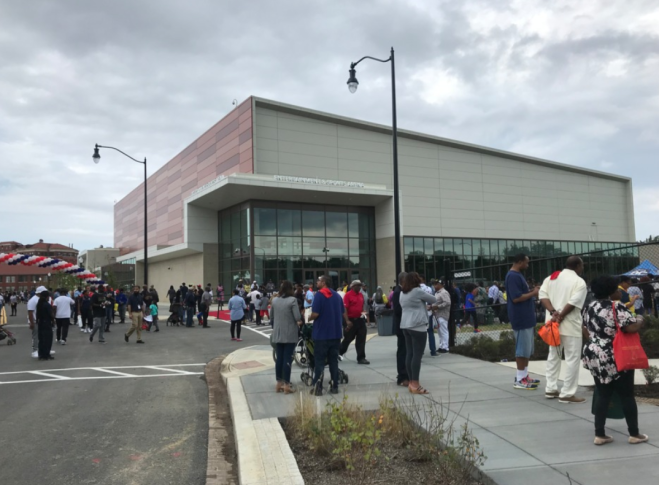
Washington D.C. Entertainment & Sports Arena (Photo credit: Kelly Soong)
GSB: Very cool, Summer. I guess I need to add the D.C. E&SA to my bucket list, too!
¹ RISE = Resources to Inspire Students and Educators
